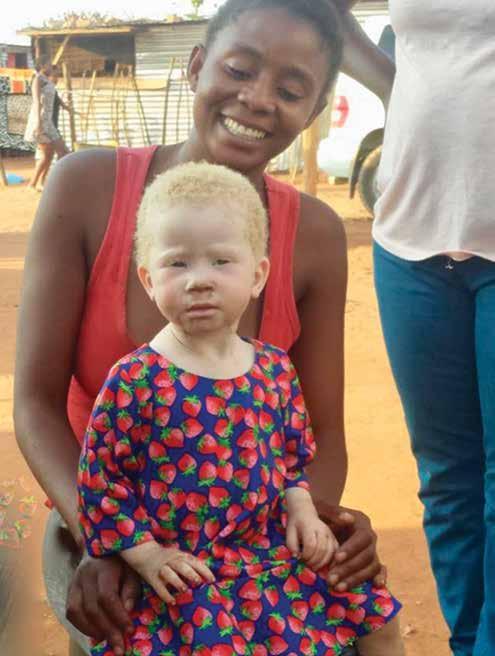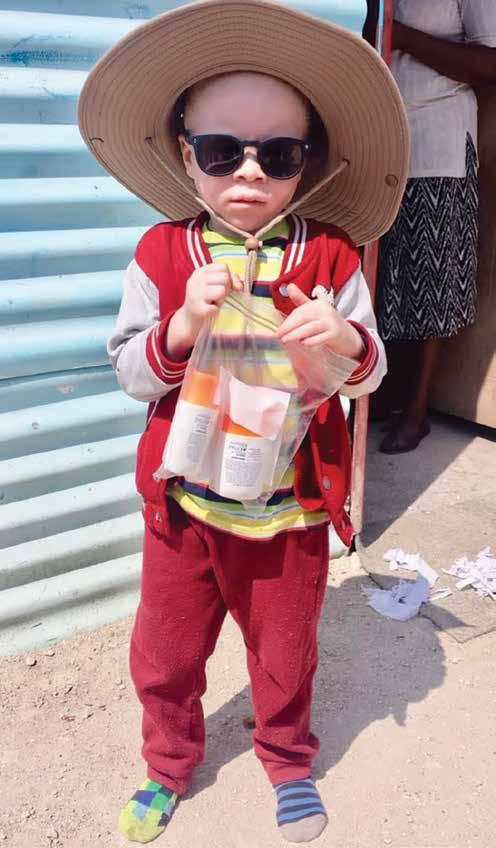
6 minute read
ALBINISM Action for inclusion with Sinasra
ALBINISM
Action for inclusion
Sinasra is a Namibian nonprofit organisation passionately committed to empowering people living with albinism. According to Toon Sanders, volunteer and passionate driver of Sinasra, this is much needed in a country with the highest ratio of people living with albinism in the world. Incredible collaborative efforts have seen great work done to assist people living with albinism here in Namibia. The work not only assists Namibians in practical ways, but has also resulted in lower levels of discrimination in Namibia than in many other African countries, and ensured Namibian representation at gatherings dedicated to best practices – for example, for Amnesty International.
“We visit albino children in the North to help them in practical ways. We take sunscreen and hats. We take them to optometrists to check their eyes
because for albino children, the degeneration of the eyes is sometimes terrible. In Tsumeb we had a girl who had minus seventeen eyesight and she’s eleven years old, so you can imagine that she didn’t see anything. How
is it possible for a girl like that to learn? Now she has glasses that were made in South Africa because they couldn’t make them in Namibia, and this is all done for free.” Toon explains: “All albino children can go to the optometrists who are part of the Namibian Optometrist Association (NOA), and have their eyes checked and get glasses for free. Sinasra has made an arrangement with this organisation, and we now have about forty optometrists throughout the country.
This is just one of the many projects Sinasra is involved in. The most recent of their projects was a collaborative effort to raise awareness for the plight of those living with albinism. Passionate people young and old came together to create ‘A song of hope’. Toon explains that one of the collaborators on the project was Michelle McLean-Bailey. She not only offered her voice to introduce the song – “She said, ‘That’s great, I’d like to do it’” – she also facilitated the involvement of the choir from Michelle McLean Primary School.
“So that’s what we did, together with some of the visually impaired children from the school in Windhoek. There were some very nice children, who love to sing,” Toon explains, adding that Dolar Yves, the Namibia-based Congolese singer, assisted the team with the lyrics. The melody was composed by Sesamstraat (Sesame Street) in Holland as Toon knows someone who writes for the popular
children’s television show. “I said, ‘Would you like to compose a song?’ So they got together and made, I think, a very nice song.”
Repeated rehearsals saw the song come to life. Being entirely dependent on donations means that recording the song was no small feat. Everything was donated. “We had to pick up the kids from various places and schools, and bring them home safely. The company Asco Car Hire said, ‘We want to do that.’ The restaurant Nyama offered the kids lunch after they finished the recording, and the Windhoek Country Club was willing to record the music video at their premises. It all worked out perfectly.”
This awareness project is one of many underway by Sinasra. As Toon explains, “We hand out sunglasses because the light is too bright. We got a very nice donation from the German Embassy for sunglasses and special glasses, and hats from FNB. We have two doctors, one at Central Hospital, and they can go there to have their skin checked. Skin cancer is one of the biggest problems for people living with albinism because they don’t have pigment.”
Toon says that they are always looking for support for the work they do. Recently, the association put together a children’s book aimed at primary school-children. While it was very well received by the Ministry of Education, the book hasn’t made its way into classrooms because of a lack of funding.
“So that’s why we said, okay if there is no funding, we have to move on with the things we have. Donations are always welcome, but all the people who work for Sinsara do it voluntarily. Nobody is paid – it’s just goodwill to people,” he says.
“In Namibia we have the highest ratio in the world of persons with albinism. We have close to 2000 persons with albinism here, so that means one in 1000 or one in 1200. Now if you compare that to countries in Europe, there it’s one in 15 000 or one in 20 000. Even in South Africa there’s one in 15 000,” says Toon.
Toon suggests that while we have the highest ratio of people living with albinism, there is less discrimination in Namibia than in other African countries. “One of the board members was asked to come to Joburg a few weeks ago to give a presentation for Amnesty International, because they want to see what Namibia is doing differently from many other countries who have organisations caring for persons with albinism.” Toon goes on to explain that in some other countries, people living with albinism face being maimed and killed.

“In a way I can say Namibia is setting a good example, but still we see that a lot of people are discriminated against or they are hidden away.”
GET IN TOUCH WITH SINASRA THROUGH THEIR WEBSITES: WWW.SINASRA.COM OR WWW.ALBINISM-NAMIBIA.ORG.
ADVERTORIAL
CHANGING LIVES ONE HOUSE AT A TIME
There is a reason why proper housing is considered a human right. When people have shelter that is safe, secure and comfortable, they are more likely to add positively to the community around them.
In 2015, to celebrate 100 years of Standard Bank in Namibia, employees identified housing as the issue they were most interested in addressing. And thus the Buy-A-Brick Initiative was born in 2015.
The provision of housing is something very close to the hearts of Standard Bank’s employees, and they have challenged other public and private partners to make housing an important pillar of their own corporate social initiatives.

The initiative raises funds with which to build houses across Namibia. Working alongside the Shack Dwellers Federation of Namibia, and using the database created and updated by them, Buy-A-Brick is able to create proper housing in communities that need it most. In 2019 alone, N$13 million was handed over to the Shack Dwellers Federation for the construction of houses across the country.
Every year, the initiative has managed to raise more and more, starting from N$1.4 million in its inaugural year. Buy-A-Brick aims to eventually build at least 1 000 houses per year, providing an essential stepping stone to prosperity for the 900 000 Namibians who live in shacks.
The need to increase formal housing in the country is clear. Since its inception in 2015, this project has made an immense impact in the lives of the many Namibians who were previously living in shacks. Recipients of the initiative’s houses have expressed happiness with how their lives have changed and how after moving into proper brick houses they now have a more positive mindset.
Every human deserves to live in adequate housing. By looking after our most vulnerable citizens, we can build up our society to be its best.










